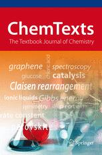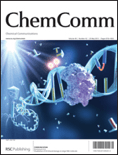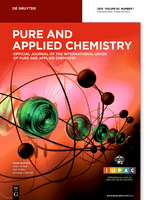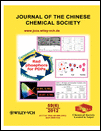
ChemTexts
Scope & Guideline
Bridging Theory and Practice in Chemical Research.
Introduction
Aims and Scopes
- Educational Reviews and Insights:
The journal publishes articles that review fundamental chemical concepts, aiming to enhance understanding and education in the field. This includes discussions on principles like Le Chatelier's principle and the van't Hoff equation. - Applications in Industry:
ChemTexts highlights practical applications of chemistry in various industries, such as the development of pressure-sensitive adhesives and the exploration of coal utilization. - Interdisciplinary Approaches:
The journal encourages articles that integrate chemistry with other scientific domains, such as biology, geology, and environmental science, as seen in topics like the chemistry of coal and the photochemistry of vision. - Historical Perspectives and Evolution of Concepts:
The journal features articles that explore the historical context of chemical theories and practices, contributing to a deeper understanding of how chemical science has evolved over time. - Analytical Techniques and Methods:
There is a strong emphasis on analytical chemistry, including methodologies for studying substances at the nanoscale and the application of various spectroscopic techniques.
Trending and Emerging
- Sustainable and Green Chemistry:
An increasing number of articles focus on sustainable practices, such as the chemistry of coal and its utilization, which indicates a growing concern for environmental impacts and resource management. - Interdisciplinary Research:
There is a notable rise in publications that integrate chemistry with other fields, such as biology and materials science, exemplified by articles on the photochemistry of retinal chromophores and the development of new materials for diagnostics. - Advanced Analytical Techniques:
The journal is increasingly emphasizing cutting-edge analytical techniques, including nanotechnology and electron microscopy, reflecting a trend towards more sophisticated methodologies in chemical analysis. - Health and Biochemistry:
Emerging themes in pharmacology and biochemistry, such as migraine drugs and genome editing tools, indicate a growing interest in the intersection of chemistry with health sciences and biotechnology. - Educational Trends in Chemistry:
There is a rising trend in articles aimed at educating current and future chemists, with insights into scientific publishing and academic career advice becoming more prominent.
Declining or Waning
- Historical Case Studies:
Although historical perspectives are still relevant, there has been a noticeable decline in articles focused solely on historical case studies of chemical practices or figures, suggesting a shift towards more contemporary issues. - Basic Principles of Chemistry:
Topics focused on fundamental principles, such as basic stoichiometry or introductory chemical concepts, appear to be less frequently published, possibly due to the journal’s shift towards more complex or applied topics. - Conventional Analytical Methods:
There has been a waning interest in conventional analytical methods, as newer and more advanced techniques gain traction in the field, indicating a move towards more innovative methodologies. - Isolation and Characterization of Specific Compounds:
The focus on detailed studies of specific compounds, such as individual minerals or chemical species, seems to be decreasing in favor of broader reviews that encompass wider applications and interdisciplinary approaches.
Similar Journals

CHEMICAL COMMUNICATIONS
Exploring the chemistry of tomorrow, today.Chemical Communications, published by the esteemed Royal Society of Chemistry, is a prominent journal within the field of chemical science, focusing on the dissemination of cutting-edge research in a variety of sub-disciplines including catalysis, materials chemistry, and electronic materials. Operating without an open access model, this journal provides critical insights from contributors around the globe, enhancing our understanding of complex chemical interactions and innovative applications. Ranked in the top quartile for several categories such as Ceramics and Composites, and Metals and Alloys, Chemical Communications boasts impressive Scopus rankings, securing strong positions across multiple fields and showcasing its influence within the scientific community. The journal is committed to advancing knowledge and fostering collaboration among researchers, professionals, and students, making it an invaluable resource for those looking to stay abreast of the latest advancements in chemistry and materials science. With a publication history dating back to 1965 and continuing into 2024, its rich archive serves as a vital repository of chemical research and development.

PURE AND APPLIED CHEMISTRY
Exploring Innovations in Chemical EngineeringPURE AND APPLIED CHEMISTRY is a highly regarded journal in the fields of chemical engineering and general chemistry, published by Walter de Gruyter GmbH. Since its inception in 1960, this journal has continued to foster advancements in chemical research and facilitate the dissemination of new knowledge through its rigorous peer-reviewed articles. With an impressive impact factor that places it in Q2 quartile rankings for both Chemical Engineering and Chemistry as of 2023, it holds a significant position in the academic landscape, attracting authors and contributors from around the globe. The journal’s unique focus on the practical applications of chemical research makes it indispensable for researchers, professionals, and students aiming to bridge theoretical knowledge with real-world applications. Although it is not open access, its impact is enhanced by its continued relevance and contributions to the ever-evolving field of chemistry. Researchers and practitioners alike will find in PURE AND APPLIED CHEMISTRY a critical resource for staying updated on key developments and innovative practices in chemistry and chemical engineering.

SOUTH AFRICAN JOURNAL OF CHEMISTRY-SUID-AFRIKAANSE TYDSKRIF VIR CHEMIE
Unleashing Potential: Chemistry Without BarriersSouth African Journal of Chemistry (Suid-Afrikaanse Tydskrif vir Chemie), published by Bureau Scientific Publications, is a pivotal open-access journal that has been disseminating groundbreaking research in the field of chemistry since its inception in 1996. With an ISSN of 0379-4350 and an E-ISSN of 1996-840X, this journal serves as a vital platform for researchers and professionals seeking to share their work and engage with the global chemistry community. Recognized for its significant contributions, the journal holds a Q3 quartile ranking in the miscellaneous chemistry category as of 2023 and ranks #216 out of 408 in General Chemistry according to Scopus. The South African Journal of Chemistry is dedicated to advancing knowledge in the discipline by publishing a wide array of articles, reviews, and studies that address pertinent chemical research and applications. With open access options available since 2000, it fosters a collaborative environment, ensuring that research is accessible to all, thereby enhancing the visibility and impact of chemists' work across South Africa and beyond.

JOURNAL OF THE CHINESE CHEMICAL SOCIETY
Exploring the Frontiers of Chemical ScienceJOURNAL OF THE CHINESE CHEMICAL SOCIETY, published by WILEY-V C H VERLAG GMBH, is a vital resource in the field of chemistry, focusing on a broad array of topics pertinent to general chemistry and its advancing sub-disciplines. Established in 1954 and running through 2024, this journal serves as a significant platform for the dissemination of high-quality research, showcasing innovative findings and developments within the chemical sciences. With its Q3 category ranking and positioning at Rank #203 in General Chemistry per Scopus, it reflects the journal's commitment to research excellence and impact. While not an open-access publication, it ensures accessibility to a global audience, making it an essential tool for researchers, professionals, and students alike seeking to stay informed and engaged in the evolving landscape of chemistry.

Ovidius University Annals of Chemistry
Connecting Researchers, Inspiring Discoveries.Ovidius University Annals of Chemistry is a prominent open-access journal dedicated to the field of chemistry and chemical engineering, published by OVIDIUS UNIV PRESS since 2012. With its ISSN 1583-2430 and E-ISSN 2286-038X, this journal seeks to foster innovative research and disseminate knowledge across diverse chemical disciplines. Situated in the vibrant academic setting of Ovidius University in Constanta, Romania, this journal receives contributions from a global pool of researchers, enhancing its relevance in the international scientific community. The open-access format ensures that all published articles are freely available, promoting a wider reach and impact of the research dissemination. As a valued resource for academics, industry professionals, and students alike, the Ovidius University Annals of Chemistry plays a crucial role in advancing the understanding of chemical sciences and engineering practices.

Canadian Journal of Chemistry
Fostering Interdisciplinary Discoveries in ChemistryWelcome to the Canadian Journal of Chemistry, a prominent publication dedicated to advancing the study of chemistry through original research and critical reviews. Published by Canadian Science Publishing, this journal has been a cornerstone of chemical research since its inception, covering a broad spectrum of topics within the field, including catalysis, organic chemistry, and general chemistry. With an ISSN of 0008-4042 and E-ISSN of 1480-3291, it provides a vital platform for researchers, professionals, and students to disseminate their findings and engage in scholarly discourse. Impact Factor is currently in development, with the journal classified in the Q4 category for catalysis and Q3 for miscellaneous chemistry fields, signifying its evolving contributions to the scientific community. The journal operates without an open access model, which ensures a rigorous peer-review process while maintaining subscription access for institutions and libraries. Located in Ottawa, Canada, the Canadian Journal of Chemistry continues to provide an invaluable resource for those dedicated to the scientific pursuit of chemistry, making significant strides in fostering interdisciplinary approaches and innovative research methodologies.

EGYPTIAN JOURNAL OF CHEMISTRY
Connecting Scholars through Groundbreaking Chemistry InsightsThe Egyptian Journal of Chemistry, published by the National Information & Documentation Centre (NIDOC), serves as a vital platform for disseminating novel research and advancements in the field of chemistry and its interdisciplinary applications. Established in 2004 and continuing its publication through 2024, this journal encapsulates a diverse range of topics including Biochemistry, Chemical Engineering, and Materials Science, reflected in its respectable Scopus rankings. With an array of Quartile rankings indicating its varying impact across different categories, scholars can benefit from its insights into innovative solutions and methodologies that address pressing scientific challenges. Although it currently does not operate under an open access model, researchers and students are encouraged to leverage its findings as it plays a pivotal role in the academic landscape of Egypt and beyond. For those engaged in chemical research, the Egyptian Journal of Chemistry stands as an essential resource, contributing significantly to the global body of scientific knowledge.

French-Ukrainian Journal of Chemistry
Elevating Chemical Research Across BordersFrench-Ukrainian Journal of Chemistry, published by TARAS SHEVCHENKO NATIONAL UNIVERSITY OF KYIV, is an esteemed open-access journal that has been contributing to the field of chemistry since 2013. With the aim to foster collaboration and knowledge exchange between French and Ukrainian scholars, this journal provides a platform for innovative research, reviews, and discussions that advance the understanding of chemical sciences. Operating under the ISSN 2312-3222, it boasts a commitment to accessibility, ensuring that all published content is freely available to researchers, professionals, and students worldwide. This initiative enhances the visibility of critical findings and insights in a rapidly evolving scientific landscape. Aimed at promoting high-quality research, the journal invites submissions that encompass a wide range of chemistry-related topics, thereby supporting the growth of interdisciplinary approaches and international cooperation in the field.

Chemija
Bridging Disciplines, Transforming Chemistry.Chemija is a prominent journal in the field of chemistry, published by LIETUVOS MOKSLU AKAD LEIDYKLA in Lithuania. With a focus on diverse topics within the realm of chemistry, this journal aims to disseminate original research articles, reviews, and discussions that advance the understanding and application of chemical science. Although it currently holds a Q4 ranking in the miscellaneous category of chemistry, Chemija is committed to elevating its impact through the publication of high-quality research, making significant contributions to the discipline. The journal operates under a non-open access model, ensuring that articles undergo rigorous peer review to uphold academic standards. Researchers, professionals, and students are encouraged to explore the wealth of knowledge within its pages as it endeavors to bridge gaps across various subfields of chemistry from 2008 to 2024. With a dedicated readership and a growing database of insightful publications, Chemija serves as an essential resource in the ever-evolving landscape of chemical research.

Foundations of Chemistry
Exploring the Roots of Chemistry Through TimeFoundations of Chemistry is a pioneering journal published by Springer, aimed at advancing the understanding of fundamental concepts in the field of chemistry from both historical and contemporary perspectives. With the ISSN 1386-4238 and E-ISSN 1572-8463, the journal covers diverse topics within general chemistry, biochemistry, and the philosophical underpinnings of the chemical sciences. Though its availability in Scopus has been discontinued following a converged publication period from 2005 to 2016, the journal remains notable for its high ranking in the Arts and Humanities, where it holds the 60th position in a competitive field, as well as its stable yet modest presence in general chemistry and biochemistry categories. This journal serves not only researchers and professionals but also students seeking an in-depth understanding of the evolution and foundation of chemical knowledge, making it an essential resource for anyone engaged in these disciplines. Readers can expect rigorous scholarship that fosters a deeper appreciation for the intricate connections within chemistry and its historical context.